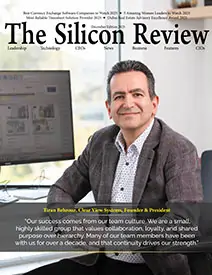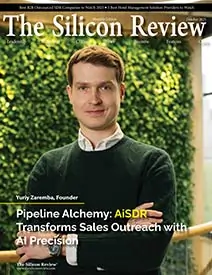>>
Industry>>
Space>>
Space Exploration Technologies...Space Exploration Technologies Corp Launches Falcon 9 Rocket: A New Era in Space Innovation
The Silicon Review
11 Febuary, 2025
On February 10, 2025, the skies above California’s Vandenberg Space Base lit up as Space Exploration Technologies Corp (SpaceX) successfully launched its Falcon 9 rocket, carrying 23 next-generation Starlink satellites into low-Earth orbit. This mission not only advanced global internet accessibility but also solidified Space Exploration Technologies Corp’s reputation as a pioneer in American space technology. For over two decades, the company has redefined what’s possible in aerospace engineering, from its humble beginnings with the Falcon 1 rocket to its current dominance with the Falcon 9. Founded in 2002 by visionary entrepreneur Elon Musk, Space Exploration Technologies Corp entered the space race with a clear goal: to slash the cost of space travel and make interplanetary life a reality. 2008 was the company's first significant accomplishment when its Falcon 1 became the first liquid-fueled rocket to reach space that was privately developed. Despite being retired a year later, the Falcon 1's legacy endures. It set the stage for the Falcon 9, a rocket that has since come to represent dependability and higher levels of innovation. The unwavering emphasis on reusability is what distinguishes Space Exploration Technologies Corp. The Falcon 9's first stage may land vertically on drone ships or return to the launch site, ready to take off again, unlike traditional rockets that were discarded after only one usage. Because of this quantum leap, launch costs have been lowered by more than 60%, making space access more affordable for businesses, governments, and academics.
Inside the Falcon 9: Engineering Excellence
The success of Space Exploration Technologies Corp. is largely due to the Falcon 9. This two-stage rocket, which was built fully in-house, is capable of carrying payloads up to 50,300 pounds (22,800 kg) to low-Earth orbit. Its versatility includes missions that aim to deploy satellite constellations like Starlink, replenish the International Space Station, and target geostationary transfer orbits. The nine Merlin engines that drive the Falcon 9 run on a mix of liquid oxygen and rocket-grade fuel. Because these engines are designed for both power and accuracy, they enable the rocket to dynamically adjust thrust while in flight. On February 10, when the first-stage booster completed its 15th successful landing, this technology proved vital in contrast to the single-use rockets of the early 2000s.
Engineering Marvels behind Falcon 9’s Reusability
Launch costs have been significantly lowered by Space Exploration Technologies Corp.'s emphasis on reusability. With little maintenance, each Falcon 9 rocket booster can fly up to 20 times. For example, on its 15th mission, the February 10 launch employed a first stage booster, which was unthinkable ten years ago. The rocket's Merlin engines, which run on a blend of rocket grade fuel and liquid oxygen, are tuned for efficiency and thrust, allowing for accurate landings on autonomous drone ships such as Just Read the Instructions in the Pacific Ocean. Some of SpaceX's Falcon 9 rocket boosters have flown up to 15 times as of May 2023, extending its reuse. These boosters are currently being certified by the firm for up to 20 flights, specifically for it Starlink missions. This advancement underscores SpaceX's commitment to rapid and cost-effective reusability, aiming for turnaround times as short as 24 hours between flights. Such engineering marvels have not only revolutionized space travel but also set new benchmarks in aerospace innovation.
![]()
Starlink: Revolutionizing Global Connectivity
Space Exploration Technologies Corp’s Starlink project is more than just a satellite network—it’s a lifeline for millions. With over 5,400 operational satellites already orbiting Earth, the recent addition of 23 satellites brings the constellation closer to its goal of 12,000. Operating at an altitude of 550 kilometers, these low-Earth orbit satellites deliver internet speeds rivaling fiber-optic cables, with latency as low as 20 milliseconds. Starlink’s impact is felt far beyond tech hubs. In 2024, during the devastating Amazon wildfires, Space Exploration Technologies Corp deployed Starlink terminals to provide real-time communication for firefighters battling flames in remote Brazilian rainforests. Similarly, rural schools in sub-Saharan Africa now access online education resources thanks to Starlink’s phased-array antennas. These stories highlight the project’s role in democratizing technology.
Starbase: Where the Future of Spacecraft Takes Shape
Nestled in Boca Chica, Texas, Space Exploration Technologies Corp’s Starbase is a hive of innovation. This sprawling facility is the testing ground for Starship, the company’s fully reusable spacecraft designed for missions to the Moon, Mars, and beyond. At Starbase, engineers push boundaries daily. The site’s 480-foot integration tower allows for rapid assembly of Starship prototypes, while its methane production plant supports the rocket’s Raptor engines, which run on liquid methane—a fuel choice critical for future Mars missions. Recent tests of Starship’s heat shield, capable of withstanding 1,650°C (3,000°F) during reentry, demonstrate Space Exploration Technologies Corp’s commitment to safety and durability.
The Road Ahead: Mars, Mega-Constellations, and More
Space Exploration Technologies Corp shows no signs of slowing down. The company plans to launch Starlink satellites weekly by late 2025, aiming to blanket the globe with high-speed internet. Meanwhile, the Starship program is gearing up for its first crewed Mars mission by 2030—a milestone that could mark humanity’s first steps toward becoming a multiplanetary species. In 2026, Space Exploration Technologies Corp opened a satellite factory in Austin, Texas, capable of churning out 45 Starlink satellites daily. Partnerships with telecom giants like Vodafone aim to integrate Starlink with 5G networks, ensuring seamless connectivity for urban and rural users. The company is also tackling environmental concerns, pledging carbon-neutral Falcon 9 launches by 2030 through methane capture initiatives.
![]()
Competing in the New Space Race
While Space Exploration Technologies Corp leads the charge, it faces stiff competition from rivals like Blue Origin and United Launch Alliance. Yet strategic collaborations keep the company ahead. Its role in NASA’s Artemis program—providing lunar landers for crewed Moon missions—and partnerships with the European Space Agency for satellite tracking underscore its influence in shaping the future of space exploration. Critics have raised concerns about space debris, but Space Exploration Technologies Corp is addressing this with AI-powered collision avoidance systems that autonomously adjust satellite orbits. The company also advocates for international policies to promote sustainable space practices, proving that innovation and responsibility can coexist.
Conclusion: A Giant Leap for Humanity
The February 10 Falcon 9 rocket launch is a testament to Space Exploration Technologies Corp’s relentless drive to innovate. From reusable rockets to global internet access, the company continues to break barriers and inspire a new generation of engineers and dreamers. As Starship prototypes take shape at Starbase and Starlink bridges divides worldwide, one thing is clear: Space Exploration Technologies Corp isn’t just reaching for the stars—it’s bringing them within our grasp. In recent months, SpaceX has achieved significant milestones that underscore its pioneering spirit. On October 13, 2024, during the fifth test flight of its Starship rocket, the company successfully caught the first stage of its Super Heavy booster using a pair of giant "Mechazilla" mechanical arms—a feat that marks a significant leap in developing fully reusable space vehicles for ambitious moon and Mars missions. Additionally, SpaceX has been rapidly expanding its Starlink constellation, with over 6,800 satellites in orbit as of December 2024, aiming to provide high-speed internet to underserved areas globally. These advancements not only highlight SpaceX's commitment to innovation but also its role in making space more accessible and interconnected for all.
_2025-12-15_12-44-58.webp)


_2025-11-17_06-38-14.webp)

 (1)_2025-10-21_13-35-14.webp)
